The "ten stars fallen from heaven"
Interview made by Catherine Ferey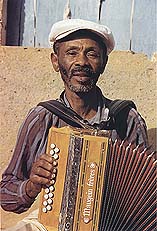
The stores Harmonia Mundi are holding an exhibition of Viviane Lièvre's works to celebrate the publication of her book
"Cape Verde, a Musical Journey in the Archipelago". The photographer-ethnologist gave us an interview in which she is evoking the people and the landscapes of the islands in a very sensitive way. Plumart : In the preface of your book, André Barbe, French Ambassador in the Cape Verde
Islands, differenciates the "so-called" wealthy islands" from the "desolate islands". In which of those two categories do you situate the ten Cape Verde islands ?
Viviane Lièvre
: The discovery of the archipelago in 1460 arose great hope in the heart of the Portuguese. Unfortunately, these islands turned out to be empty, desolate and barren lands, even if they were
greener than nowadays. The conquerors were far from finding the same richness as that of Madeira or the Azores.
To exploit these lands, they had slaves come from Guinea. The history of the
Archipelago is a tough one -a convulsive meeting between colonizers and slaves- since it quickly became one of the first way station in the triangular trade. Pl : Is it the trace of this past that you are trying to recapture in the Cape
Verdean music ? A music that, Jean-Yves Loude, in the text he wrote for your photographs, has described as follows : "a suave music united to a poetry devoted to love and soul sufferings".
Viviane Lièvre
: It is first and foremost as an ethnologist that the Cape Verde Islands fascinate me. The archipelago history is unique if we consider that it
did not have any autochtonous population. It also is a difficult one since colonialism has been harshly lived. And yet interbreeding is a real fact there.
Tracking down the elements of African culture within this crossbred culture is a long and subtle work. African roots are very little claimed. The Cape
Verdean people has created itself on its land, just as its history has. For instance, only very few names from African clans are remaining. Animism is
not practised either. The origins have almost completely been forgotten after five hundred years of cultural hijacking. With the conquest of independance in
1975, a desire to rediscover the links with Africa has emerged, even if those links are quite tenuous.
I am also very sensitive to the warm welcome of the inhabitants and their
pleasure to make their islands known, or rather their island since each of them fiercely claims an identity of its own. The musical styles are here to assert
those differences. Santiago, where half of the Cape Verdeans live, is certainly the most African island. This appears through four different musical traditions :
Tabanka, Batuku, Finaçon -which is very close to the art of African griots- and lastly Funanà, in a way, the missing link between African musical tradition and Mississipi blues. Landscapes also impress me for their volcanoes of course, but mostly for their variety ranging from the beaches of Boa Vista to the volcanoes of Fogo. Fogo
is a magical island with its 1700 metres high volcano. A community has settled within its extinct crater -a community which is descended from Armand de
Montrond, a French adventurer who had taken refuge in the island in the 19th century. Vineyards are growing on the slopes of this volcano ! Moreover, Fogo is the only island of the archipelago where people drink wine.
The Cape Verde Islands are demanding islands ; they do not allow easy clichés and superficial exotism.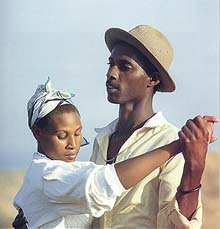
The main reason why I deeply admire this people is that it has been able to resist in such a tough environment. Daily
life is very often a question of survival. Ressources are scarce. The subsoil does not conceal any richness. Fishing is the only lucrative activity. Without international aid and the money sent by
exiled Cape Verdeans, life would almost be impossible. In spite of this harshness, music is omnipresent. It is very sensual and often mistakenly compared to fado. Funanà music, which, according to
Jean-Yves Loude, is "a succession of popular chronicles in which sexual performances reply to the offences of misery", has nothing to do with salsa. Its rhythms are completely different.
I admire these people for their savoir vivre and the serenity they show in any occasion in spite of the difficulties they meet in their everyday life.Pl
: How do you situate your photographic work ? When do you consider it as a complement to your ethnologic missions and when does it belong to artistic creation ?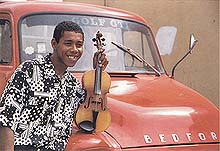
Viviane Lièvre : My work as an ethnologist has always come with
photographs that are more ethnological than artistic. Then, the artistic work has gradually become more and more present even if I kept a feeling of proximity and humanity towards my
subject. My photographic style is never gratuitous nor exotic.
My photographic approach is based on the concept of meeting, whether the meeting of the other or the striking
meeting with landscapes. Aesthetic concerns come second.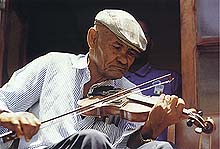
In Cape Verde, a Musical Journey in the Archipelago, I wanted to work on portraits. The photographs of landscapes are here to show the connivance I felt
between the musicians and their land. This book is the first collection of color photographs ever realized about the Cape Verde Islands. After the publication by Actes Sud of Cape Verde Islands, Atlantic Notes
-a collection of travel stories- we have had many requests for images of this unknown archipelago. This is the reason why I wanted to offer this visual complement,
both to the book and to the work of musical memory collecting, which was the goal of our last journey.
The tape recordings we made of Cape Verdean musics will contribute to the
enrichment of the archipelago's national archives. This work of protection was a vital one since many of the musicians -guardians of the musical traditions- are
getting very old now. In Brava, the composer and violonist Raùl Pinal is now 97 years old. Not without humour, he admitted that his mornas "were his
greatest sin" ! In Santo Anto, Nhô Ksyk will soon be 90 years old. But when he is on stage, mazurkas, waltzes and coldeiras still stream from his violin. Pl
: Your portraits give the impression of a quiet wisdom even though all these musicians spent their lives playing in popular festivals and public dances.
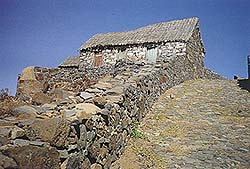
Viviane Lièvre : This was deliberate. I made most of these
portraits just before the recordings. This is why the atmosphere is not festive. Moreover, don't forget that they are portraits. I have intentionally chosen to photograph the leader of each band on his own.
These photos also constitute the tribute I have decided to pay to these musicians. All of them are talented, authentic and completely unknown. They are passionate and simple people. Whatever their age, the pleasure they
take in playing has remained intact. All of them learned to play by ear. The creation of two music schools in the archipelago is very recent. These portraits might well be the only ones to be preserved.
Pl : Why did you also put photos of children in your book ?
Viviane Lièvre : I did not want this book to be just a collection of portraits
of musicians, even if they are its main concern. Children take part in all the festivals, and their presence is really significant. This is why they also appear in this book. Bibliography
Viviane Lièvre and Jean-Yves Loude
Cape Verde, a Musical Journey in the Archipelago, La passe du vent editor
Cape Verde, Atlantic Notes, Actes Sud editor, 1997
Jean-Yves Loude - Ana Désir, La passe du vend editor, 1999
Era Na 47, L'Urdla editor, Centre Européen de l'Estampe, 1997 Translated by Françoise Marel
|